Net showcase is a platform for communication between producer and buyer

Mohsen Hajizadeh, CEO and co-founder Net showcase And Jalal Fahmi is the product manager and co-founder of this business. They have been able to attract capital in three rounds from Dimond, Smart Up and Mushfaq Industrial Group to advance their business. The efforts of Mohsen and Jalal have paid off and Net’s showcase has experienced a monthly growth of 68% in the last year. Mohsen and Jalal see themselves at the beginning of the path and have various plans for the development of the Net showcase.
How was Vitrin Net born?
Mohsen: “We started Showcase Net in the middle of 1995 and we thought that a business similar to Alibaba, which is a website B2B e-commerce to create in Iran.
“To tell the story of formation in more detail, before Vitrinnet, I was planning to create an online clothing store called Jackal, and I was looking for a group that would do the technical work of the website. At that time, Jalal had a company that did website design and development. We met because of this. Jackel didn’t make it to the end, but getting to know Jalal made me refer to him a year later when I had the idea of starting a website similar to Alibaba.com.”
“The idea was to create a platform where businesses, especially manufacturers, introduce their products there and we establish a relationship between the manufacturer and the buyer. We intended to generate income from advertising and our business model was to sell subscriptions.
“Jalal welcomed the idea and with the addition of Roya Kian Bakht, who was Jalal’s colleague, we created a team of three people. Within 2 months, we created the initial version of the website and started fundraising to continue the work.”
What made you decide to go with Mohsen?
Jalal: “Before Mohsen made his proposal, Roya and I had a company and we were doing a website development project, but we had come to the conclusion that it was not a scalable job, so we were looking for an opportunity to do a scalable job. . The first opportunity that arose was to work with the Dimana team, which had been accepted into Avatech and asked us to take over the technical part of their work, but we did not achieve results with this team. It was in this situation that when we came across Mohsen’s proposal, it was attractive to us and we decided to cooperate.”
How did the first fundraising go?
Mohsen: “We prepared a list of accelerators to attract initial capital, but of course we didn’t have many options at that time. We presented our plan to Diamond and Avatech and finally entered Diamond. Our reason for entering Dimond was networking and to be able to communicate with the investors who come and go there.
“We entered Dimond in early 1996. At Dimond, we were looking for new ideas to create added value on the website of Vitrine Net. One of these ideas was that in addition to images, it is possible to use video to introduce the product. With this work, the attractiveness of the work increased and we also got income. After some time the question arose as to why we limit the supply side to manufacturers, we decided to open up the space so that anyone can sell anything they want on the website. The result was that business activity increased, but due to their great variety, we had become like a wall-like advertising website. We returned from this path and this time we focused on machines and equipment. After this turn, we were able to attract capital from SmartUp.
How did you manage to focus your work?
Mohsen: “In order to focus, we first divided the B2B E-Commerce sector into three sectors: machinery and equipment, raw materials and major goods, which because the sector related to machinery and equipment had fewer players and was a kind of blue ocean, this sector we selected. Of course, we did a detailed comparison process and checked factors such as volume and size of transactions or access to audiences through different channels. In the machinery and equipment sector, we went to agriculture, food industry and packaging. The reason for this choice was the variety of products and different prices for each product.
How did the fundraising from Smartup come to fruition?
Mohsen: “At the end of the course we spent at Dimond, we had more than 60 meetings to attract capital, and we finally came to a conclusion with Smart Up. The business model we had at that time was not accepted by SmartUp, but they counted on the perseverance of the team and trusted us.
In the first stage, they raised some problems with us and we were able to implement part of the improvements that were intended within a week. After this, they provided us with a limited amount of capital, and it was decided that if they receive positive feedback, the main investment will be made, which is what happened.”
“With the arrival of Smart Up, we experienced a new environment. The high level of mentoring services, the transfer of experiences between active businesses in the group and the breadth of communication that existed in Smart Up. It helped us grow better.”
How was your business during this period?
Mohsen: “With continuous negotiations, more manufacturers were attracted to the website and we used SEO techniques to attract buyers.” We experienced good growth and had good sales, but the income that the subscription model generated for us was very small compared to the size of financial transactions in the machinery and equipment market. At the end of 1997, we planned to change the income model.”
How did you come to the conclusion that you need to change the revenue model?
Mohsen: “One of the problems of the subscription model was that many leads were generated for some producers, but many of these leads were not checked. This situation conveys the feeling that the value of the work being done is not properly understood with this model.
“The basic problem was that according to the revenue model of the subscription fee, if we covered all the activists in the same area, the ratio of our income to the transaction created with the help of our site would be insignificant.”
What were the consequences of this change of income model?
Mohsen: “We were thinking about making this change, and in the meantime, Mushfaq Industrial Group was added to the group of investors of Vitrine Net. Mushfaq’s opinion was that considering the good record we had in implementing the subscription model, we should continue the same. It was in September 1998 that we realized that we were on the wrong path and we implemented the same change that we had planned before, which led to a continuous monthly growth of 68% until now.
How did the interaction with Mushfaq Industrial Group take place?
Jalal: “We were looking for attracting new capital and we had several options, but the combination of capital and shares offered by Mushfaq Industrial Group was more attractive than the rest. Showcase Net was the first start-up investment of the Mushfaq group, and considering that after that other markets such as the stock market were more attractive for this group, they have not made any other investment in the start-up field.
What made the monthly growth of 68% in the net showcase?
Mohsen: “Before the rotation, we talked to a large number of users and got feedback. On the part of the buyers, it was raised that we see the products on the website, but when we intend to buy, the buying process is not facilitated. The manufacturers also claimed that they have many advertising channels and therefore the added value that can be created is not in the product introduction department but in facilitating the sales process.
“According to these feedbacks, we now operate as a sales arm for manufacturing companies, managing operations such as sales and shipping, and providing sales support services such as a return guarantee.”
“The growth that happened in Vitrine Net was influenced by the rotations we had, but two other factors also influenced our growth. The first factor was the small but continuous improvements we pursued, and the second factor was that we understood exactly what we wanted to sell. We realized that our customers don’t buy a device from us, they buy a business. For example Home businesses What device they buy determines the shape and limits of their business.
With this growth that has happened, what position does Vitrine Net have in the market?
Mohsen: “In terms of the number of visits and transactions, we have the first position in the market. If we had a serious competitor, maybe it would help us to develop faster. There are similar sites, but they are different from us in terms of the part of the market that they focus on, for example, Amdeks is a B2B E-Commerce startup that focuses on the wholesale sale of goods.
What is your plan for the development of Vitrinnet? Are you planning to attract capital?
Mohsen: “We are interested in attracting capital so that we can implement the plan we have planned for development. In this program, we have foreseen two measures and we will continue continuous improvements along with them. The first step is to create the first showroom Net showcase is to be able to provide introduction and sales services in physical form. We expect this measure to increase our sales up to 3 times. The second step is to create a content factory, because content is poor in our field of activity.
“Besides these measures, we also plan to add new categories of machines. So far, we have focused on agricultural machinery and equipment, food industry and packaging, and we plan to cover 10 to 12 new areas in the discussion of machinery and equipment in the next year.
How do you rate this article?



